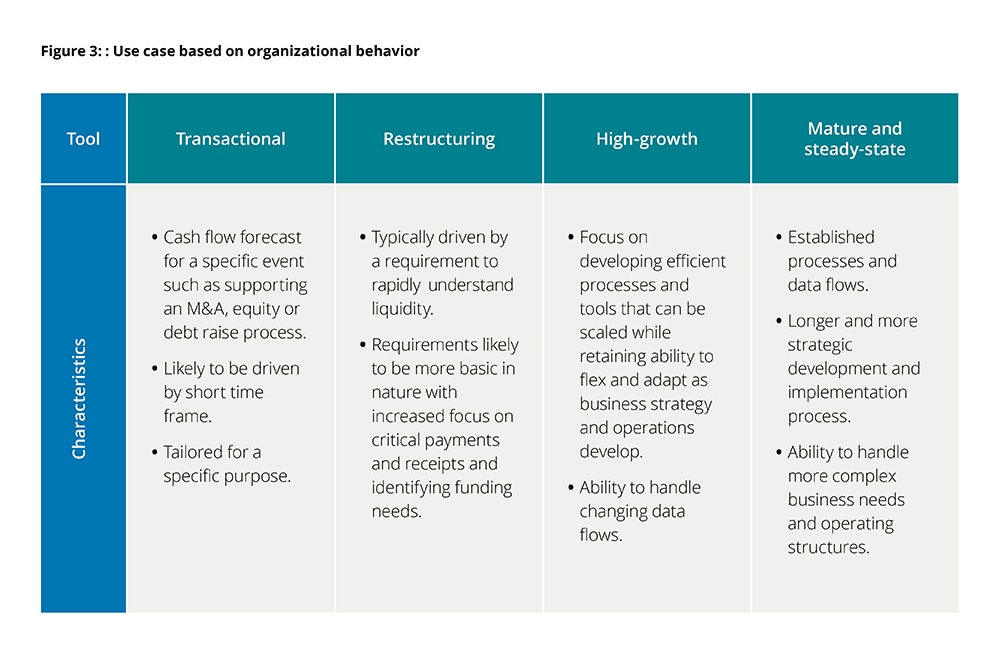Pursuit of a fit-for-purpose cash flow forecasting tool has been saved

Perspectives
Cash flow forecasting is much more than selecting software. An apt model will strike a good balance between implementation time, resources available to support the platform, and desired functionality. Explore why companies must assess what is appropriate for their needs.
Active liquidity management remains a strategic business need for finance leaders who seek to gain competitive advantages through effective capital allocation, understanding of liquidity opportunities and risks, and building resilience. That journey requires a myriad of considerations including foundational governance and process maturity as discussed in a previous piece emphasizing the building blocks required prior to implementing a tool that activates the measurement and management of cash flow.
While foundational governance is the cornerstone of active liquidity management, the forecasting tool used to project weekly liquidity is the centerpiece that translates a process into a tool that enhances visibility, identification of root-cause issues, and predictability of cash flow further into the future.

Companies that embrace leading practices in active liquidity management not only build the governance foundation first, but also undertake a critical assessment of factors such as organization size, number of business units, enterprise resource planning (ERP) and subsystem infrastructure, sophistication and capabilities of internal data teams, timeframe for implementation, and overall forecasting process maturity before selecting a forecasting solution. These forecasting solutions, as seen in figure 1, range from traditional spreadsheet modeling to enterprise-wide strategic system Software-as-a-Service (SaaS) platforms that can be fully integrated into other planning systems.
A few of the common pitfalls of choosing the wrong forecasting solution can leave organizations with issues that become endemic to the point where forecasting becomes a time-consuming, unsustainable process where most of the time is spent compiling the forecast.
When defining the objectives, the organization should consider a range of factors: How quickly is the information required; what data input sources are available; what outputs and analytics are needed; what is the usage time and frequency; what process, governance, and team structures are in place to support the tools and systems; and how likely and how often are any of these factors expected to change? If full consideration is not given to these options, the organization risks not getting the information it needs in a timely manner for prudent yet efficient decision-making.
As seen in the figure below, cash flow forecasting solutions should consider specific aspects of how an organization intends to behave both presently and in anticipation of future state organizational changes.

Modeling a direct cash flow, or another form of the financial forecast, for a stand-alone activity (e.g., M&A, special projects, debt raise, restructuring) with a limited scope and low volume data set is typically best handled using a tool that offers flexibility and ease of use and doesn’t require an extensive implementation process. A time-tested tool of choice that has these attributes is the traditional spreadsheet.
There are inherent limitations to using spreadsheets—they are highly reliant on a user’s ability to structure and develop a model that is fit-for-purpose, avoids the unnecessary risk of error, and is understandable for other users.
Management should begin to consider whether it needs a full enterprise system implementation or not. Part of this decision is understanding what could be achieved through a combination of a spreadsheet and fit-for-purpose data analytics tools such as Azure SQL Database, Power BI, or Tableau as these more ubiquitous tools can provide organizations with significant capabilities while avoiding the time and cost of a full enterprise system implementation.
An agile platform should be built on strong existing foundations but with the ability to grow and adapt as the organization’s structure and needs change over time.
An organization-wide strategic system that is capable of handling complex business needs while recording and maintaining large volumes of financial data from many users will typically be best achieved through an ERP package. This will require a significant upfront investment in both capital and time. It would also be suited to larger-scale organizations with more mature processes and resources. Potential choices in this space would include platforms from major ERP and accounting software providers–many of which offer different packages but typically include full cloud accounting software and customizable product plans that range from forecasting to human resources to supply chain and more.

Implementing the right tools and systems now sets the foundations for strong cash and liquidity management. Creating a cash-focused business not only will enable the organization to better navigate volatility in a rapidly changing landscape but also will create awareness and opportunities to pursue strategic investment initiatives. This is best achieved through strong foundational governance and the selection of a forecasting tool that will provide the right balance of organizational needs with the least amount of friction to get the process up and running for both near-term utility and long-term sustainability.
Donald Wallace |
Jordan Moore |
Benefits of having a strong cash management foundation
How companies can position themselves for resiliency